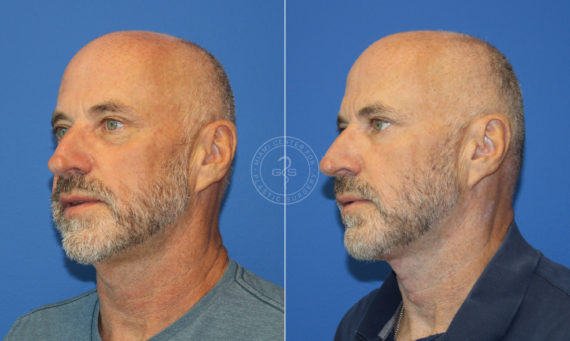
Facelift surgery is becoming more common among men who want to look younger. It’s important to know how facelifts work for men, what choices are available, and what the process involves before deciding to proceed. Choosing a surgeon with experience in male facelifts, such as Gabe Salloum, M.D., F.A.C.S., is important. An experienced surgeon can explain the risks and how to prepare, helping men feel assured about their decisions.
Essential Insights on Male Facelifts
- Male facelifts are tailored surgeries that help reduce signs of aging by tightening facial skin and improving overall appearance.
- Men considering a facelift should look for a surgeon experienced in addressing unique male facial structures and skin characteristics.
- The recovery period for a male facelift varies, but patients typically return to work within two weeks, with full activity resumption after four to six weeks.
- Understanding the potential risks and setting realistic expectations with your surgeon can lead to more satisfying facelift outcomes.
- Non-surgical alternatives to facelifts, such as fillers or Botox, can offer men less invasive options for facial rejuvenation.
Why Men Opt for Facelifts

Men choose facelifts for many reasons, all important and shared by many who seek this type of cosmetic procedure.
- Improving confidence is a big reason. A facelift can greatly enhance a man’s self-esteem, making his outside look match how he feels inside. This can lead to a fresh burst of energy and self-worth.
- Advancing careers also motivates men to get facelifts. In job markets where looking younger is linked to being seen as energetic and capable, keeping a masculine appearance helps. A facelift can help maintain a strong, skilled look, which may lead to new job opportunities and career advancement.
- Lastly, men aim for a youthful and masculine appearance in males resulting from societal expectations. Many strive for a look that fights off signs of aging, showing how much our culture values staying young and full of life.
Facelift Before and After Pictures


*All patients are unique and individual results may vary.
Exploring Facelift Options for Men
Men looking to improve their appearance have a range of facelift procedures available to them, each designed to target specific issues and achieve certain results. A traditional facelift provides a comprehensive makeover, tightening the skin across the face for a fresher, youthful look. For those focusing on loose skin around the jowls and neck, lower facelifts and neck lifts offer a more defined jawline, enhancing masculine features.
Mini facelifts are suited for men with less noticeable signs of aging. This less invasive option has shorter recovery times. Along with the minimal incision facelift, it tightens skin and reduces wrinkles with smaller cuts. The deep plane facelift goes under the skin and muscle to adjust the deeper layers of facial tissue. This method, which includes the Preservation Deep Plane Facelift, gives a natural facelift look without the tightened skin appearance.
Liquid facelift are a non-surgical choice, using injections to smooth out wrinkles and add volume. While these treatments are temporary, they can be a good fit for men not ready for the commitment of surgery. The combination facelift blends several techniques for a tailored approach to facial refreshing.
Men interested in facial improvements should talk to a specialist to look into these options and figure out the best plan for them, considering their aesthetic desires and physical needs.
Each facelift method offers its own advantages. Traditional facelifts target the entire face, mini facelift and minimal incision facelift are for less aging signs, and deep plane facelift and Preservation Deep Plane Facelift adjust deeper facial structures for a natural facelift outcome. Liquid facelift provide temporary improvements, and combination facelift allows for a customized solution.
It’s important for candidates for facelift surgery to consider all facelift approach and alternatives to facelift surgery, including the detailed deep plane facelift technique, to choose the option that best suits their needs.
Step-by-Step Breakdown of the Facelift Process for Men
Your First Appointment
Your journey begins at the first appointment, where the facelift consultation takes place. During this time, you and your facelift surgeon discuss your goals and assess if you’re a good candidate for the procedure. This important step makes sure you and your surgeon have the same expectations.
What Happens on Surgery Day
On the day of the surgery, you’ll understand the specifics of facelift surgery. Your surgeon customizes the techniques based on your unique needs, aiming for results that look natural. This tailored approach is important for meeting your goals.
Navigating the Recovery Journey
The phase right after your surgical facelift is crucial for a smooth healing process. It involves managing swelling and discomfort. You’ll get detailed instructions to help minimize complications and enhance your recovery.
Understanding emotional recovery is also vital. It takes time and support to adjust to your new look. In the weeks following the surgery, you’ll see the swelling and bruising gradually improve. The final results, revealing a refreshed appearance, highlight the importance of both emotional and physical recovery in the success of the facelift.


SPECIALIST CARE YOU CAN TRUST
Dr. Salloum is supported by a brilliant team of caring staff members.
You can trust the entire staff to help make your visit as comfortable and safe as possible!
Addressing Concerns: Risks and How to Cope
When thinking about getting a facelift, it’s important to know about possible side effects and ways to lower your risks. Understanding common side effects and strategies to reduce risks can guide your decisions. The complications of facelift surgery, like infection, hematoma, and nerve injuries that might change your skin’s appearance, are uncommon but important to consider. Opting for a natural facelift can help address many of these concerns by maintaining the skin’s integrity.
To reduce risks, keep these in mind:
- Picking a surgeon with a deep understanding of skin, particularly in handling crepey skin and loose skin, as they require gentle care.
- Implementing a personalized plan for before and after the surgery to support your skin’s health. This plan might cover staying hydrated, eating well, and steering clear of activities that could stress your skin.
- Considering a natural facelift for its aim to improve the facial structure while avoiding overly tight skin. This approach can result in a more natural look and possibly a quicker recovery.
By considering these factors and preparing properly, you can aim for a safer procedure and be happier with the results.
Getting Ready for Your Facelift
Preparing for your facelift involves steps to ready both your body and mind, ensuring you’re fully prepared for the experiences during and post-surgery.
Your Pre-Surgery To-Do List:
- Gather necessary supplies for aftercare.
- Arrange for someone to assist you immediately following the procedure.
- Create a comfortable healing area in your home.
Setting Recovery Expectations: Understanding the healing process is crucial, as it varies with different skin types. For instance, skin with hair follicles and thicker skin will react differently to a facelift, influencing your final appearance.
Men considering a facelift have two primary options:
- Natural Facelift: Targets lifting and tightening the skin, especially around the cheek skin, for a rejuvenated appearance.
- Liquid Facelift: Utilizes injectables to reduce wrinkles and provide fullness, offering a non-surgical alternative suitable for those seeking minimal downtime.
It’s vital to discuss the distinctions between thicker skin and sensitive skin with hair follicles with your surgeon to establish realistic expectations for your surgery outcomes and recovery period.
Partnering with the Best Surgeon for Your Facelift
Choosing the right surgeon is essential for anyone thinking about a facelift. It matters for your safety, satisfaction, and the quality of the outcome. The first thing to check is their credentials. You should look for a board-certified plastic surgeon—or even better, a double board-certified facial plastic surgeon. Being certified like this shows they have gone through extensive training and testing in facial plastic surgery.
Facelift patients need a surgeon with a lot of experience. Surgeons who specialize in facial procedures know more and can do better than those who are general plastic surgeons. Plastic Surgery covers a wide range of procedures, but facial plastic surgeons focus their work on the face and neck.
It’s your right to have all your worries addressed. A good surgeon will welcome your questions. They should make the effort to make sure you’re well-informed and at ease during your private consultation.
Thinking about getting a facelift is a big step, and it’s important to get advice from someone who knows what they’re doing. Dr. Gabe Salloum works at the Miami Center for Plastic Surgery and is really good at cosmetic surgery, especially when it comes to the face and body. He’s all about making sure he understands what you need and giving you the attention you deserve.
To find out more about your facelift options and start feeling more confident and beautiful, talk to Dr. Salloum. Schedule a consultation with him today.